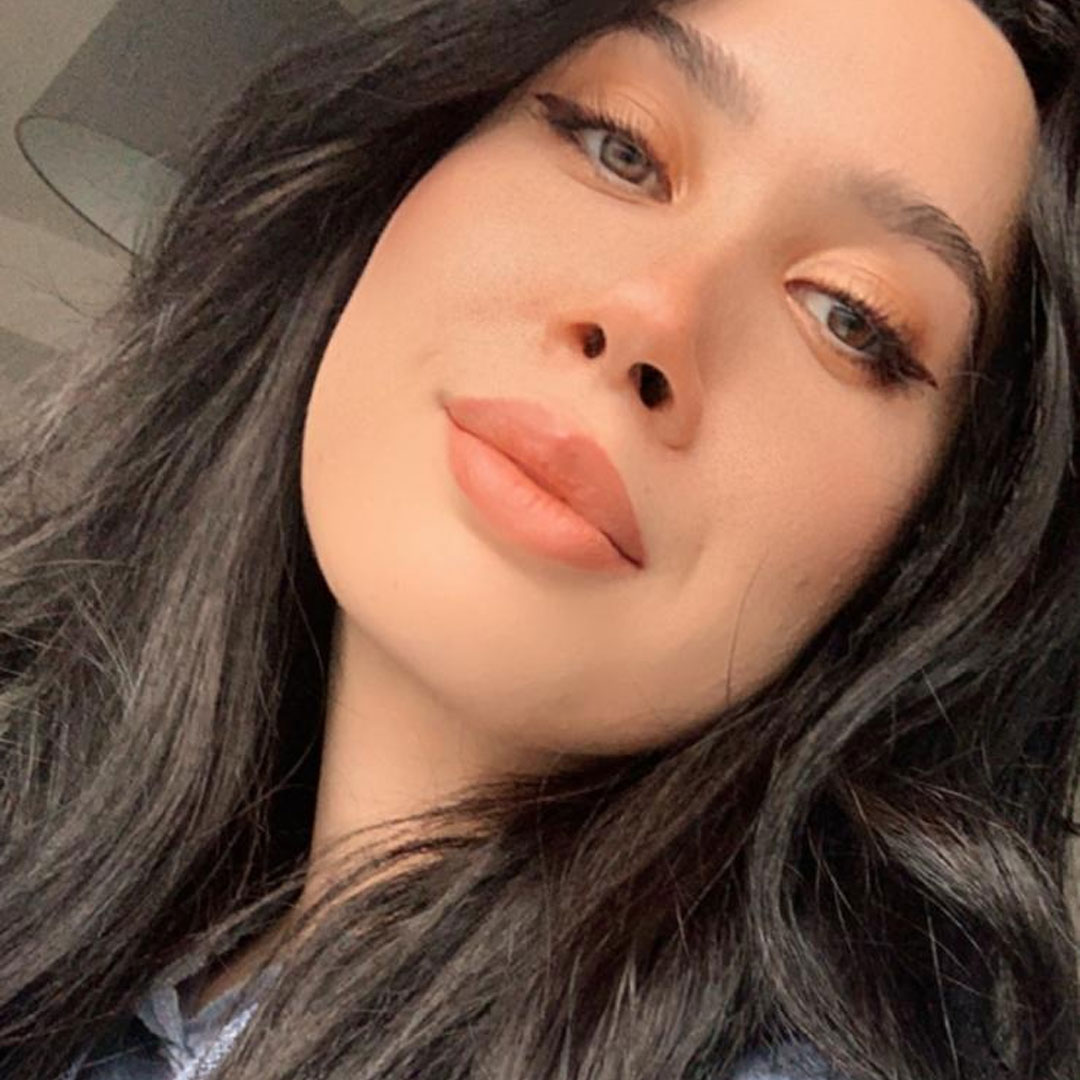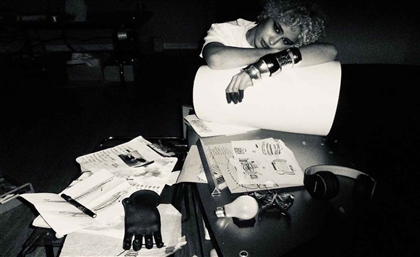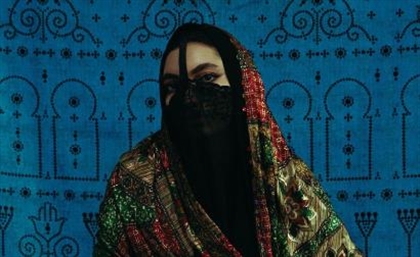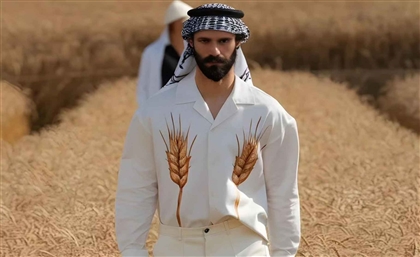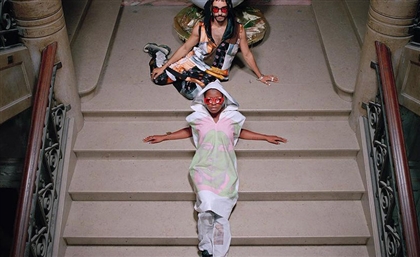Embroidery & The Intifada: Palestinian Dress as Resistance
It is through actively weaving together the Palestinian narrative, that women and men alike were given the space to counter and resist erasure, a right they were never afforded.
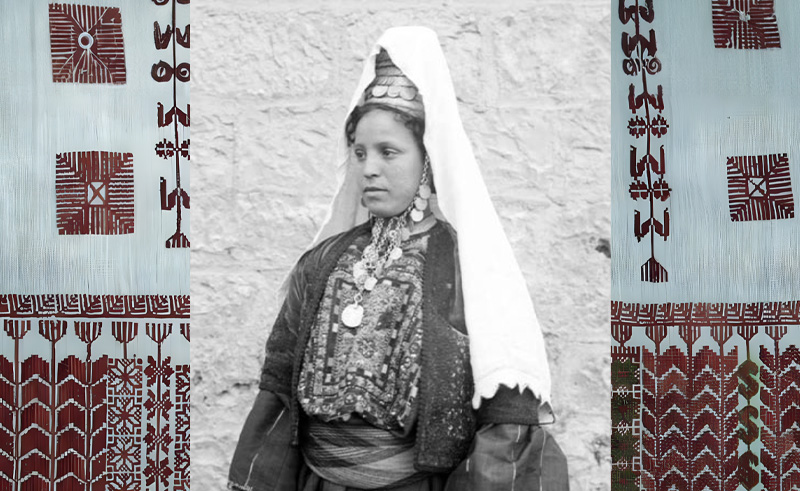
For hundreds of years, Palestinian women have gathered their fabrics, needles and thimbles to etch their stories into their thobe (dresses) - a tradition inherited from their mothers and skillfully immortalised through their daughters. It is at the mere age of seven that they start conceptualising their wedding trousseau, working alongside their elders to confidently yield their tools and stitch together the future they envisioned. The colourways chosen portrayed a light yet undimmed by violence, stitches unappropriated and undiluted by oppressors, and the enduring hope for a brighter tomorrow.
To truly understand the thobe's history, we must recognize the profound impact of the Israeli occupation, particularly the mass expulsion of Palestinians during the establishment of Israel in 1948. In that tumultuous era, many Palestinians left their homes with little more than the dresses they wore, imbuing the thobe with the essence of a bygone, unspoiled, and free Palestine. Its cultural significance experienced a resurgence after the first intifada in 1987, marked by non-violent Palestinian protests against the Israeli occupation of the West Bank and Gaza.
-d715ea47-488f-4bd3-b697-eaa1e29520b4.jpg) At the heart of the thobe lies a unique form of geographical signalling, as Iman Saca describes, “In social gatherings with other women from adjacent villages or towns, women had no need to ask where the other women came from, for their places of origin were apparent in the dresses they wore.” Each thobe becomes a vivid map of a woman's village of origin, a tapestry that proudly displays the area's cherished symbols, “Women from Beit Dajan often embroidered an orange blossom on their dresses, for this village was known for its orange orchards. Cypress trees embroidered between the orange blossom motifs symbolised the boundary between the orange orchards. A careful observer, however, would be able to recognize if a woman wearing an orange blossom dress advertising her residence in Beit Dajan was originally from a different village by taking note of motifs and stitches that were not typical of Beit Dajan.”
At the heart of the thobe lies a unique form of geographical signalling, as Iman Saca describes, “In social gatherings with other women from adjacent villages or towns, women had no need to ask where the other women came from, for their places of origin were apparent in the dresses they wore.” Each thobe becomes a vivid map of a woman's village of origin, a tapestry that proudly displays the area's cherished symbols, “Women from Beit Dajan often embroidered an orange blossom on their dresses, for this village was known for its orange orchards. Cypress trees embroidered between the orange blossom motifs symbolised the boundary between the orange orchards. A careful observer, however, would be able to recognize if a woman wearing an orange blossom dress advertising her residence in Beit Dajan was originally from a different village by taking note of motifs and stitches that were not typical of Beit Dajan.”
-b110cfa5-7adb-4a05-a8a1-fc500ca78790.jpg) In an interview conducted by Tania Nasir with art historian Widad Kamel Kawar for The Journal of Palestine, Kawar recollects the moment everything unfolded: “In 1948 the Arab-Israeli war took place, and with it Palestinian prosperity and stability were shattered. Palestinian culture and tradition were shaken to their roots. Palestinians by the thousand left their homes out of fear, and many were forced to flee. The Palestinian problem was created. Poverty and malnutrition in the camps became a way of life. Women started selling their precious and beautiful costumes and jewellery to provide food for their families. I myself bought a few of these costumes, and I suddenly realised the urgent need to collect them and save them from being lost, at the same time helping to preserve one important aspect of our village culture.”
In an interview conducted by Tania Nasir with art historian Widad Kamel Kawar for The Journal of Palestine, Kawar recollects the moment everything unfolded: “In 1948 the Arab-Israeli war took place, and with it Palestinian prosperity and stability were shattered. Palestinian culture and tradition were shaken to their roots. Palestinians by the thousand left their homes out of fear, and many were forced to flee. The Palestinian problem was created. Poverty and malnutrition in the camps became a way of life. Women started selling their precious and beautiful costumes and jewellery to provide food for their families. I myself bought a few of these costumes, and I suddenly realised the urgent need to collect them and save them from being lost, at the same time helping to preserve one important aspect of our village culture.”
-130bdcc3-d507-4d6f-a584-b2b6a40e383c.jpg) It is through Kawar’s testimonial lens that scholars were able to denote that traditional Palestinian dress and embroidery, these symbols of life in exile, transcend mere indicators of familial lineage. They are material conduits to an elusive past, silent testimonies that resonate in ways that memory, place, and even people, in their ephemeral existence, cannot capture. As Saca delineates, “despite the political and economic difficulties, women in the refugee camps, mainly in Jordan and Lebanon, continued to embroider in the style of their original villages in an attempt to maintain their displaced identity.”
It is through Kawar’s testimonial lens that scholars were able to denote that traditional Palestinian dress and embroidery, these symbols of life in exile, transcend mere indicators of familial lineage. They are material conduits to an elusive past, silent testimonies that resonate in ways that memory, place, and even people, in their ephemeral existence, cannot capture. As Saca delineates, “despite the political and economic difficulties, women in the refugee camps, mainly in Jordan and Lebanon, continued to embroider in the style of their original villages in an attempt to maintain their displaced identity.”
-4aa35336-6225-499f-a2eb-709235ccb335.jpg) Over time, the thobe transformed into a symbol of resistance against the occupation. As Rachel Dedman notes in her book ‘At the Seams: A Political History of Palestinian Embroidery’: “The historic thobe conjures an ideal of pure and untouched Palestine, before the occupation. [...] Suddenly, in the face of dispossession and cultural appropriation by Israelis, embroidery became an urgent task.” The stories stitched across the thobe began to boldly challenge the Israeli ban on public displays of Palestinian nationalism with vibrant, striking designs featuring Palestinian flags and maps. Armed with nothing but the needles they’ve inherited and the memories of their ancestors, artisans took to mapping their war-torn homes and a Palestine unsullied by the white man’s violence.
Over time, the thobe transformed into a symbol of resistance against the occupation. As Rachel Dedman notes in her book ‘At the Seams: A Political History of Palestinian Embroidery’: “The historic thobe conjures an ideal of pure and untouched Palestine, before the occupation. [...] Suddenly, in the face of dispossession and cultural appropriation by Israelis, embroidery became an urgent task.” The stories stitched across the thobe began to boldly challenge the Israeli ban on public displays of Palestinian nationalism with vibrant, striking designs featuring Palestinian flags and maps. Armed with nothing but the needles they’ve inherited and the memories of their ancestors, artisans took to mapping their war-torn homes and a Palestine unsullied by the white man’s violence.
It is through the active weaving together of the Palestinian narrative, that women and men alike were given the space to counter and resist erasure, a right they were never afforded. In the words of Hagar Salamon, “It seemed to me that this vivid story was describing an object that lay at the intersection between the craft of embroidery, memories of a lost patrimony, and the uncompromising declaration of ownership - all wrapped up with intense emotions.”
-a0514679-e53f-44bb-8dfa-00f3efc741ec.jpg) As settlers further occupied Palestinian ground, the thobe’s roots were tampered with and appropriated, resulting in an increased emphasis on the embroidered mapping of the country. The thobe remained a crucial part of the charge against genocide erasure but the active stitching and framing of the country’s map mobilised the immortalisation of pre-occupation Palestine. As Salamon states, “The attempt to touch inaccessible Palestine by embroidering the map is also associated with the attempt to touch inaccessible young family members. [...] The needlework is colourful and large, describing the borders of pre-1948 British-Mandate Palestine; place names and images are located in their respective geographic locations. The names of towns and cities of Palestine of that era are stitched in Arabic letters and pictorial images, while non-Palestinian towns and cities are ignored.” These handcrafted works, born from an urgent need to preserve what is left “mediate between the rather abstract ideas of historical justice and very concrete images, linking them to their own children, their own lost homes as well as to the beauty that had vanished into thin air. For all members of the family these are attached to the mother, the wife, and the daughter enduring persistence to keep these memories alive by the force of embroidery.”
As settlers further occupied Palestinian ground, the thobe’s roots were tampered with and appropriated, resulting in an increased emphasis on the embroidered mapping of the country. The thobe remained a crucial part of the charge against genocide erasure but the active stitching and framing of the country’s map mobilised the immortalisation of pre-occupation Palestine. As Salamon states, “The attempt to touch inaccessible Palestine by embroidering the map is also associated with the attempt to touch inaccessible young family members. [...] The needlework is colourful and large, describing the borders of pre-1948 British-Mandate Palestine; place names and images are located in their respective geographic locations. The names of towns and cities of Palestine of that era are stitched in Arabic letters and pictorial images, while non-Palestinian towns and cities are ignored.” These handcrafted works, born from an urgent need to preserve what is left “mediate between the rather abstract ideas of historical justice and very concrete images, linking them to their own children, their own lost homes as well as to the beauty that had vanished into thin air. For all members of the family these are attached to the mother, the wife, and the daughter enduring persistence to keep these memories alive by the force of embroidery.”
-d06f73c2-1940-41b4-ac56-f7824691fba9.jpg) Now, more than ever, it's important to engage with the works of Widad Kamel Kawar, Iman & Maha Saca, Hagar Salamon, Silman Mansour, Nabil Anani, Shelagh Weir, Rachel Dedman and others alike, in order to keep stitching the narrative of Palestinian resistance.
Now, more than ever, it's important to engage with the works of Widad Kamel Kawar, Iman & Maha Saca, Hagar Salamon, Silman Mansour, Nabil Anani, Shelagh Weir, Rachel Dedman and others alike, in order to keep stitching the narrative of Palestinian resistance.
Photos Courtesy of Maha & Iman Saca's 'Embroidering Identities: A Century of Palestinian Clothing'
- Previous Article Monochrome Monday: The Dark Wash Denim Edition
- Next Article Mapping Palestinian Resistance Through the Keffiyeh
Trending This Month
-
Nov 17, 2024

